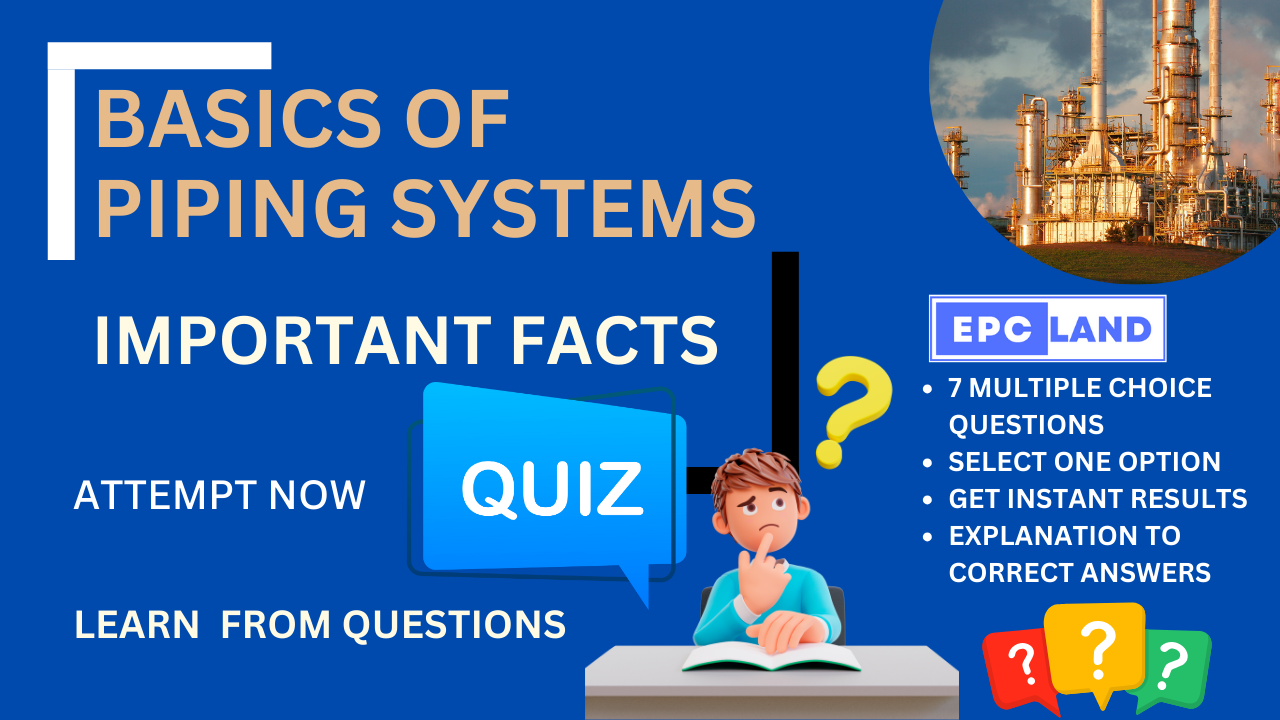1. What is a piping system?
Which of the following best describes a piping system?
Explanation: A piping system is a network of pipes, valves, and fittings for fluid conveyance, making option B the correct answer.
2. Components of a piping system
What is the basic building block of a piping system?
Explanation: Pipe sections are the basic building blocks of a piping system, making option B the correct answer.
3. Design conditions
What are the specified design conditions for a piping system?
Explanation: The specified design conditions for a piping system include fluid type, flow rate, pressure, temperature, corrosion, and vibration, making option B the correct answer.
4. Importance of piping systems
What role do properly designed and maintained piping systems play?
Explanation: Properly designed and maintained piping systems play a crucial role in transporting fluids safely and efficiently, making option B the correct answer.
5. Piping System Applications
In which industry are piping systems used to transport raw materials, intermediate products, and finished products?
Explanation: Piping systems are used in chemical processing to transport raw materials, intermediate products, and finished products, making option C the correct answer.
6. Piping System Components
What is used to connect pipes together and provide a leak-proof seal?
Explanation: Flanges are used to connect pipes together and provide a leak-proof seal, making option C the correct answer.
7. Fluid Control in Piping Systems
What components are used to control the flow of fluid in a piping system?
Explanation: Valves are used to control the flow of fluid in a piping system, making option C the correct answer.
Short Article on Basics of Piping Systems
What is a piping system?
A piping system is a network of pipes, valves, and fittings that conveys fluid from one location to another. Piping systems are essential for a wide variety of applications, including:
- Chemical processing: Piping systems are used to transport raw materials, intermediate products, and finished products in chemical plants.
- Oil and gas production: Piping systems are used to transport crude oil, natural gas, and refined products in oil and gas fields and refineries.
- Power generation: Piping systems are used to transport steam, water, and other fluids in power plants.
- Water and wastewater treatment: Piping systems are used to transport water, wastewater, and sludge in water and wastewater treatment plants.
- HVAC systems: Piping systems are used to transport hot and cold water and refrigerant in HVAC systems.
Components of a piping systems
A piping system consists of the following components:
- Pipe sections: Pipes are the basic building blocks of a piping system. They are typically made of steel, plastic, or fiberglass.
- Fittings: Fittings are used to connect pipes together and change the direction of flow. Some common types of fittings include elbows, tees, reducers, and crosses.
- Flanges, gaskets, and bolting: Flanges are used to connect pipes together and provide a leak-proof seal. Gaskets are used to seal the joint between two flanges. Bolting is used to tighten the flanges together.
- Valves: Valves are used to control the flow of fluid in a piping system. Some common types of valves include gate valves, globe valves, ball valves, and butterfly valves.
- Pipe supports and restraints: Pipe supports and restraints are used to support the weight of the pipes and prevent them from moving or vibrating excessively.
Design of a piping system
Each individual component of a piping system, as well as the overall system, must be designed for the specified design conditions. These design conditions typically include the following:
- Fluid type: The type of fluid that will be transported through the piping system.
- Flow rate: The amount of fluid that will be transported through the piping system per unit time.
- Pressure: The pressure at which the fluid will be transported through the piping system.
- Temperature: The temperature at which the fluid will be transported through the piping system.
- Corrosion: The potential for corrosion of the piping system components.
- Vibration: The potential for vibration of the piping system.
Importance of piping systems
Piping systems are essential for the operation of a wide variety of industries. They play a critical role in transporting fluids safely and efficiently. Properly designed and maintained piping systems can help to prevent leaks, spills, and other accidents that can damage the environment and harm human health.
Table of Contents
Don’t miss the Course on Effective Isometrics Management: Check Now
Enrollment Link
Recommended courses (Published on EPCLand)
- Complete Course on Piping Engineering
- Basics of Piping Engineering
- Piping Layout Engineering
- Piping Material Engineering
- Piping Stress Analysis
- Material Requisitions
- Piping Material Specifications
- Valve Material Specifications
- Plant Design & Layouts-OISD 118
- Isometric Management
Library of Technical Articles
Don’t miss out the collection of 15+ articles on following topics:
- Basics of Oil and Gas Industry
- Valves
- Testing
- Tank
- Piping Bulk Items
- Pipe
- Metallurgy
- Piping Materials
- Layout
- Instrumentation
- Heat Exchanger
- Type of Contracts
- Codes and Standards
- ASTM Standards
- Articles on Piping Specialty Items
Video details of Complete Course on Piping Engineering
Why Enroll in the EPCLand
Proven Track Record– PTR
Activities & Achievements before launching EPCLand
- Published more than 50+ short courses
- 3000+ Enrolments
- More than 3,500,00 Minutes of watch hours in the last 2 years
- 4000+ Students in 100+ Countries
- Rating of 4+ out of 5
- 1000+ YouTube Videos
- 8K+ Subscribers
What Students will Learn
- Codes & Standards of the Energy Sector
- Piping Material Engineering
- Piping Layout Engineering
- Stress Analysis
Interesting facts
- All the published courses have been developed by Industry Experts with more than 2 decades of experience
- Content is based on Practical experience and real-time problems.
- Content is designed and organized in such a manner that it can be easily grabbed.
- Complete website, Blogs and Quiz sections are Planned, Designed and published by myself (About me: Atul Singla)
- Complete flexibility of Time & Location, Students can access the content from anywhere & anytime
- Moreover, once enrolled, the content can be access as many times as you want, which helps in understand the fundamentals in a better way.
Conclusion
In conclusion, our courses are meticulously crafted by industry experts with over two decades of hands-on experience. The content is rooted in practical knowledge, addressing real-time problems. The material is thoughtfully designed and organized for easy comprehension. Every aspect, from the website to blogs and quizzes, has been planned, designed, and executed by Atul Singla, ensuring a comprehensive and seamless learning experience. With the flexibility of accessing the content at any time and from any location, students have the freedom to learn on their terms. Furthermore, enrollment grants unlimited access, allowing learners to revisit the material as often as needed, fostering a deep understanding of the fundamentals.


